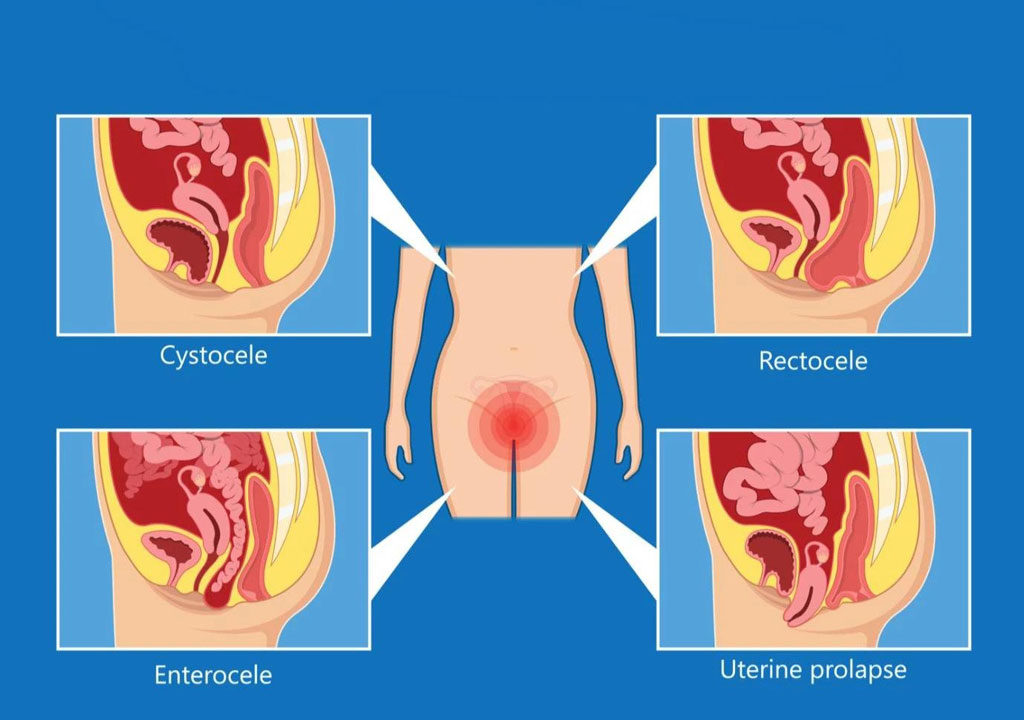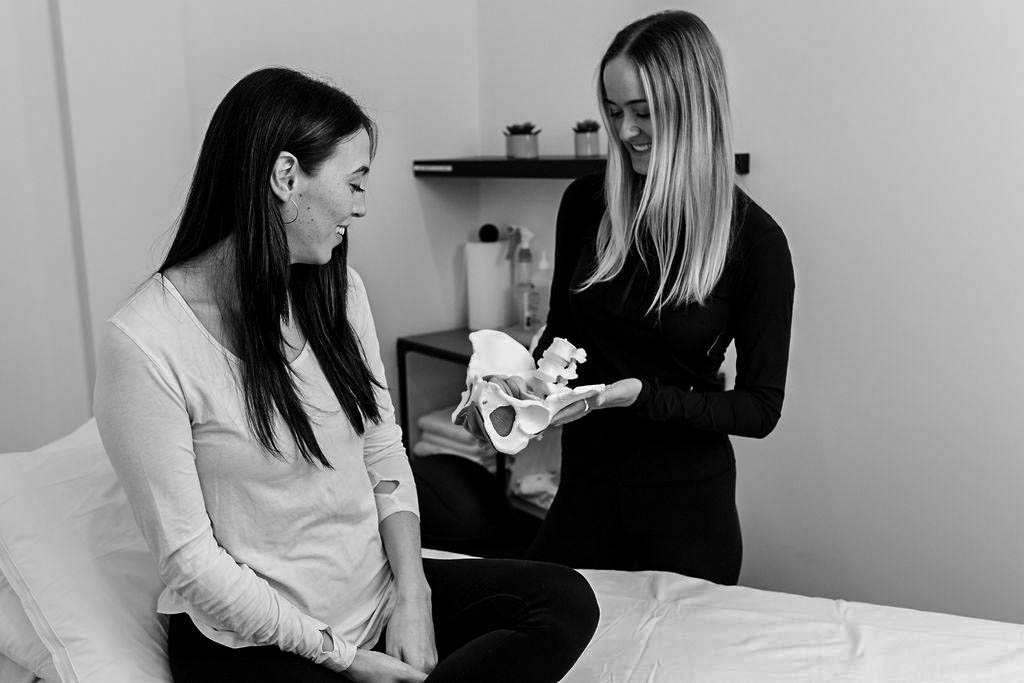What is Pelvic Organ Prolapse?
A Pelvic Organ Prolapse (POP) occurs when one or more of the pelvic organs descend toward the bottom of the pelvis from their normal position. Your pelvic organs consist of the bladder/urethra, rectum, and uterus (for biological-cis female populations). There are structures inside the pelvis that help support these organs inside the pelvic cavity; these structures include connective tissue and ligaments that anchor the organs to the bony structure of the pelvis.
The main muscular support of the pelvic organs is your pelvic floor! When injury, dysfunction, or weakening occurs to these supportive tissues, whether it be to the pelvic floor muscles themselves or the ligaments or connective tissues, the organs may drop (or prolapse) down in the pelvis toward the vagina.
This can occur for a variety of reasons, such as pregnancy, childbirth, menopause, chronic coughing, persistent straining for bowel movements, repetitive heavy lifting, weight gain, or any other activities that cause excessive pressure onto your pelvic floor and pelvis. As you can see, there are many reasons you can develop a prolapse, whether you have had children or haven’t!
Symptoms of Pelvic Organ Prolapse
Many people who develop POP experience symptoms related to their prolapse. However, a portion of people living with POP do not experience any symptoms at all and are considered asymptomatic.
Common Symptoms of POP include:
- Pressure/heaviness/fullness in the pelvis
Sometimes reported as the sensation that “something is falling out” of the vagina or rectum. Typically worsened with prolonged standing or walking, impact activities, heavy lifting, and exercise
- Urinary symptoms
Leakage, increase urge to empty your bladder, or difficulty completely emptying the bladder
- Pain during intercourse
- Constipation
- Difficulty emptying or completely emptying the bowel
- Tissue protrusion near or at the vaginal opening
- Lower back pain
Types of Pelvic Organ Prolapse

Anterior vaginal wall prolapse (Cystocele or Urethrocele)
- This type of prolapse occurs when the fascia surrounding the bladder and urethra will stretch, weaken, or detach from the pelvis. Without this support, the bladder will drop into the vagina and may be visible either inside or at the vaginal opening.
- This is the most common type of prolapse reported in research today.
Posterior vaginal wall prolapse (Rectocele or Enterocele)
- A posterior wall prolapse occurs when the muscular support or connective tissue between the vagina and rectum is damaged or injured from its attachment sites. This causes the rectum or small intestine that attaches to the rectum to fall into the vagina.
- One common cause/symptom of this type of prolapse is chronic constipation, including persistent straining to evacuate stool or infrequent bowel movements
Apical prolapse (Vaginal Vault or Uterine Prolapse)
- The uterus will prolapse or descend toward the opening of the vagina when the vaginal walls, ligaments, and/or pelvic floor muscles weaken or lack structural integrity.
- The superior portion of the vagina (called the vaginal vault) can lose support from the vaginal walls and collapse into the vaginal canal. This commonly occurs after a hysterectomy procedure and can commonly co-occur with a cystocele, rectocele, or enterocele
How to Prevent and Treat Pelvic Organ Prolapse
If you suspect you could have a prolapse, always book an evaluation by your family doctor, gynecologist, or pelvic floor physiotherapist. Most prolapses can be addressed successfully with conservative treatment strategies, however surgery may be necessary in some individual cases.
Here are some tools & suggestions for managing your prolapse symptoms:
🍉 Strengthen your Pelvic Floor!
One of the pelvic floor’s main roles is to provide support to the pelvic organs that sit inside the pelvis. When these muscles are lacking strength and not functioning properly, they can cause or contribute to the development of prolapse. Research supports the use of pelvic floor muscle training for treating mild to moderate pelvic organ prolapse, as well as the use of pelvic floor strengthening in alleviating prolapse related symptoms.
🍉 Limit or Try to Avoid any Activities or Movements that Increase Pressure onto your Pelvis
This means no straining or pushing to empty your bladder and bowel. Perineal splinting in this case can be helpful to provide counter pressure and support. For exercise, one rule of thumb we always tell our clients is to “blow before you go”. This means exhaling out when you are doing a movement that requires effort and adds load to your body.
🍉 Optimize your Bowel Movements!
This can look like using a stool under your feet when having bowel movements (like a Squatty Potty!), having regular bowel movements, and having adequate fibre and water intake to help with intestinal motility.
🍉 Use Lube for Sexual Intercourse!
This can help penetration feel more comfortable, and reduce friction on the tissue(s) internally.
🍉 Legs Up the Wall
If you feel any pressure or heaviness in your pelvis, lie on your back with a pillow under your hips and your legs up the wall.
- Position yourself so that your head is lower than your hips, and your legs can be straight or bent slightly.
- Hold this position for a few minutes, performing deep breathing or doing some pelvic floor contractions!
This position allows gravity to bring the pelvic organs further up inside the pelvis, and can help alleviate the feeling of pressure on the bottom of the pelvis.
Savanna Rowe, MPT
🍉 Registered Interim Physiotherapist
Bump Physio & Co is a community of health care providers dedicated to changing the way pelvic health and obstetrical services are delivered. Our two clinics locations are Port Moody and Langley BC, where we treat beyond the Bump and welcome clients from all stages and phases of life! Our team has advanced training in Pelvic Health, Orthopedics, Obstetrics, Clinical Pilates, and Active Rehabilitation.
Please follow us along on our socials @bumpphysio.co to keep updated on all that is going on and for more information about how the Bump Community can help YOU!
Citations
Barber, M.D., Maher, C. Epidemiology and outcome assessment of pelvic organ prolapse. Int Urogynecol J. 2013. 24(11): 1783-1790.
Braekken, I.H., Majida, M., Engh, M.E., Bo, K. Morphological changes after pelvic floor muscle training measured by 3 dimensional ultrasonography: A randomized controlled trial. Obstet Gynecol. 2010. 115(2 Pt 1): 317-324.
Goldstein, S.D., Maxwell, P.J. Rectal prolapse. Clin Colon Rectal Surg. 24(1): 39-45.
Hagen, S., Stark, D., Glazener, C., Sinclair, L., Ramsay, I. A randomized controlled trial of pelvic floor muscle training for stages I and II pelvic organ prolapse. Int Urogynecol J Pelvic Floor Dysfunct. 2009. 20(1): 45-51.
Uzoma, A., Farag, K.A. Vaginal vault prolapse. Obstetrics and Gynecology International. 2009. P. 1-9.
Weintraub, A.Y., Glinter, H., Marcus-Braun, N. Narrative review of the epidemiology, diagnosis, and pathophysiology of pelvic organ prolapse. Int Braz J Urol. 2020. 46(1): 5-14.
